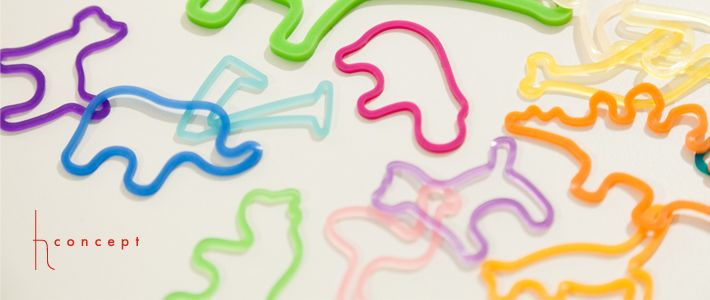
H Concept: Playful Designs to Enliven the World
Economy Science Technology- English
- 日本語
- 简体字
- 繁體字
- Français
- Español
- العربية
- Русский
Unique Designs and Skyrocketing Sales
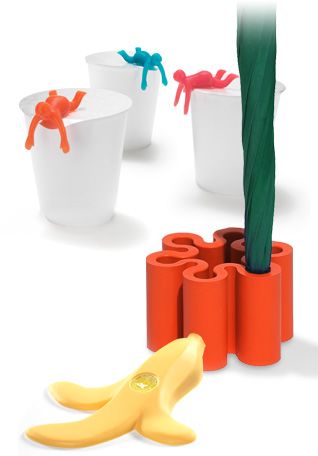
The Japanese company H Concept breathes life into ideas for new designs, turns them into commercial products, and then markets them. All of the company’s products feature fun designs that will make you smile as soon as you see them; for example, a figurine that diligently holds down the lid of a cup of instant noodles after the boiling water is added, a colorful umbrella stand with a design like a splash of water, or a doorstopper shaped like a slippery banana skin. These everyday accessories featuring unique design twists are marketed around the world under the +D brand name.
The first product born of a +D design, released in 2002, was the animal rubber band—a set of silicon rubber bands shaped like elephants, giraffes, and other creatures. They serve the same function as ordinary rubber bands, but no matter how many times you use them they always return to their original shapes. These first caught the attention of the shop at New York’s Museum of Modern Art (MoMA), and shops at other museums, such as the Guggenheim Museum in New York and the Design Museum in London, subsequently began to stock them. Their popularity has boomed and they are currently sold in more than 30 countries.
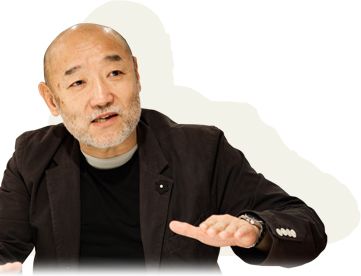
“Making good use of design will undoubtedly change
a company,” says Nagoya. His words carry weight,
as he speaks from experience.
The president of H Concept, Nagoya Hideyoshi, graduated from art school and went to work at a manufacturer of everyday consumer goods with a history stretching back over 100 years. While the company stressed product quality, Nagoya felt that the design of the products lacked forcefulness. He set about creating his own designs, while revolutionizing the company with such initiatives as setting up a planning and design office and increasing the number of staff working on designs. His efforts paid off, with sales skyrocketing more than tenfold.
Nagoya’s own experience convinced him that design has tremendous power to inspire people. He launched his company out of a desire to use design to liven up the everyday world.
Consideration Is the Key to Good Design
“People tend to think that design is all about the attractiveness or a beautiful shape,” Nagoya notes. “That is certainly important, but if that were all there is to it, design would be the same as art. The big difference between art and design is that whereas art is all about self-expression, design involves making things while bearing in mind the people who will use them. So, really, design is about consideration for others.”
The Japanese people in particular are often said to be very considerate of others. In the aftermath of the massive earthquake and tsunami that struck on March 11, 2011, the international media were full of praise for how people facing desperate conditions calmly assisted each other without rioting.
“The Japanese consideration for others extends to the workplace as well,” Nagoya points out. “If you can communicate just 80% of what is needed, Japanese people will respond with 130% of their ability. Thanks to this characteristic, Japanese designers are among the best in the world.”
Creating Something out of Nothing
Nagoya places great importance on meeting other designers who create their own unique designs—whether at design competitions or at one of the university classes he teaches. And these days more and more designers are bringing their ideas directly to H Concept.
“When someone brings an idea along, we first circulate it among all the staff,” Nagoya explains. “That way, we get uninhibited feedback from the perspective of the design users. Based on this feedback, I then discuss the idea with the person in charge of development, and we repeatedly talk to the designer as well. A product meeting is also held every week or two to gain input from our sales staff as we refine the idea.”
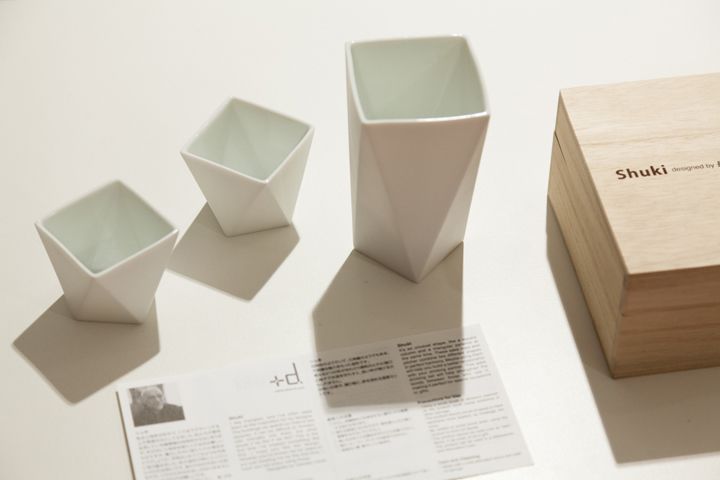 A set of drinking vessels designed for H Concept by the architect Chō Daisaku, who celebrated his 90th birthday in 2011—the same year the vessels went on sale.
A set of drinking vessels designed for H Concept by the architect Chō Daisaku, who celebrated his 90th birthday in 2011—the same year the vessels went on sale.
New ideas develop through that multi-staged process, and the design may sometimes end up as a product rather different from the original idea, as Nagoya explains:
“A designer is a person with the creative ability to create something out of nothing. In other words, someone who can create a thing—even if it isn’t fully formed—that simply had not existed before. And our work comes down to multiplying that original act of creation by a factor of a hundred or a thousand. Of course, unless you have that original designer, there is nothing to multiply in the first place and the result is zero. This is why, in order to liven up our everyday world, I first want to provide encouragement to designers.”
Reflecting this outlook, the name and face of the designer is clearly indicated for all +D products. And profits from the sale of products are returned to the designers in part as royalties.
“This gives designers a sense of responsibility, so that they put everything into what they do,” Nagoya points out. “I would be delighted if +D provided the impetus for designers to broaden the scope of their work.”
KONCENT Shop Serves as a Power Source
As well as working on its +D brand, H Concept offers design consulting for a range of companies producing such items as stationery or traditional handicrafts. In February 2012, products in the +D line and from six other brands for which H Concept handled consulting were exhibited at the Ambiente exhibition in Frankfurt, one of the largest exhibitions of everyday consumer goods in the world.
“We had buyers approaching us from all over the world thanks to the exhibition,” Nagoya notes. “These clients included the Container Store, a US-based specialist storage shop; the Frozen Fountain, an interior shop in Amsterdam; and MoMA. We had inquiries for business amounting to around ¥30 million, and sales during the exhibition alone added up to several million yen.”
Around the time as this success overseas, H Concept opened its first bricks-and-mortar shop in Japan.
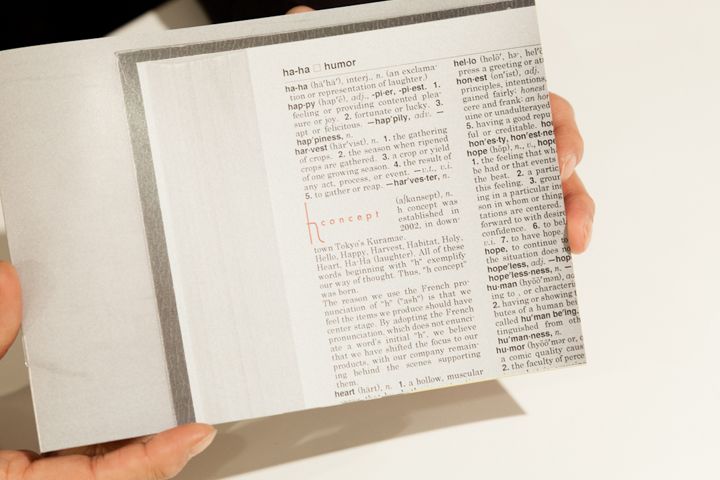 Nagoya shows the cover of the H Concept company brochure designed like the page of a dictionary, with the company name set alongside positive words starting with the letter H, such as “happy,” “honest,” and “hope.”
Nagoya shows the cover of the H Concept company brochure designed like the page of a dictionary, with the company name set alongside positive words starting with the letter H, such as “happy,” “honest,” and “hope.”
“One of our employees in charge of sales proposed the idea of creating a shop selling H Concept products,” Nagoya recalls. “I could see how motivated he was, so I decided to launch the shop with him as the manager. I always want to do whatever I can to help our employees achieve their ambitions. Even if it is an area in which you have no experience, you should be able to succeed as long as you seriously consider what needs to be done to please other people. This considerate attitude is the key, both when it comes to managing the company and doing design work.”
The shop that sells H Concept products is called Koncent, derived from the Japanese word for “electrical outlet” (konsento, from “concentric plugs”).
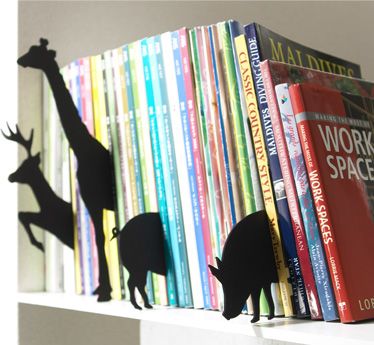
“Animal index” markers popping out of the spaces between books
to let someone known the exact place where a book was removed.
“I hope the shop will become what I call a ‘design platform’—a meeting place for all sorts of people. I named the shop Koncent because I want it to serve as a power source for customers, designers, manufacturers, and the media, connecting all of them to each other.”
The products H Concept offers could not be described as things a person simply can’t live without. Rather, they are things that are fun to own; things that make you feel good and energize you. Aiming to create those kind of products is what has made the company unique.
“People are playing it safe these days, because of the prolonged recession, trying to avoid making any mistakes,” Nagoya observes. “But precisely because the current period is so gloomy, we want to do something interesting and invigorate the world with fun designs.”
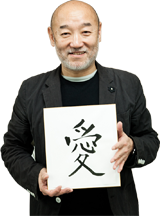 A Message from the Company President
A Message from the Company President- President Nagoya Hideyoshi with the Chinese character ai, meaning “love.”
- Design is all about consideration for others, which can be expressed in the single word “love.” People feel an attachment—a type of love—for things that have a captivating design. In part because of today’s environmental concerns, the twenty-first century will not be an age of disposable goods. Just as design is love, I think that using something that has been affectionately designed is also love.
- Corporate Data
-
- Company name: H Concept Co., Ltd.
- Address: 2-4-5 Kuramae, Taito-ku, Tokyo 111-0051
- Representative: Nagoya Hideyoshi, Representative Director
- Business: Planning, manufacture, importing, and wholesaling of household and everyday consumer goods; design consulting; import agency
- Capitalization: ¥30 million
- Employees: 16
- Website:http://www.h-concept.jp/
(Originally written in Japanese by Tsuda Hiroshi. Photographs by Matsumura Takafumi.)
design designer SMEs KONCENT platform everyday consumer goods MoMA Guggenheim Museum Design Museum in London Nagoya Hideyoshi Ambiente exhibition